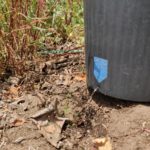Drought-tolerant container gardening
As we experience aridification (let’s call it what it is, and “drought” is inadequate to describe the magnitude of th is), here’s what I am doing for the flowerpot / container section of my garden.
- Hard edit. If a plant is not a drought-tolerant plant, or a drought-tolerant variety, away to compost it goes. Some drought-tolerant plants I’m moving into the garden proper, because there they’ll be easier to keep hydrated through the long months of heat.
- Repotting. Plants grow. You can make a general presumption that their “downstairs” (root ball inside the soil) is at least as big as their “upstairs” (visible foliage and branches). If you see a large puffy “upstairs” coming out of a tiny “downstairs”, that’s a pretty good indicator that your plant will be root-bound, won’t have access to much soil to absorb and hold moisture, and will wilt and fail when temperatures spike later this summer. Moral of the story is: Eliminate all those tiny pots. Use the largest containers you possibly can, because a larger soil mass dries out much more slowly. Make your plant forget it’s in a container, make it think it’s in the ground.
- Saucers. Every pot on my patio is getting a saucer. That way, when I water and the water flows through, the runoff is captured and has a chance to be reabsorbed (instead of running off across concrete to evaporate). True, there could be issues of salt accumulation (harvested rainwater, if you have it, would help to clear this), but at this point getting adequate moisture to your plants is far more critical.
- Mulching. Every year in April and May, I refresh the mulch to cover the soil surface. My favorite mulches are found materials: the grapefruit leaves that fall onto my patio, the cassia tree leaves that gather on the roof of my shed, or wood chips repurposed from a tree pruning service. You can also purchase bagged bark chips.
- Shade. I’m moving some containers to locations where a building, a tree, or a piece of patio furniture will offer part-day shade.
- Stacking. On my baker’s rack, I’m aligning pots one above the other so that overflow from the top-shelf plants pours into the pot directly below. In other locations, I’m settling a smaller pot directly on top of the soil of a larger pot.
- Shading the root ball. I arrange my potted plants in tight clusters. It looks cool, but at the same time the foliage and pot of the front-line-soldiers can shade the pot and rootball of the others. Fewer pots bake in direct exposure to the sun. Of course, the front-line-soldier plants need to be the most heat- and drought-tolerant.
- Consistency. I hand-water my container plants, and (confession time) consistency of watering isn’t one of my strengths. “When I feel like it” doesn’t grow strong, resilient plants. I’m trying to set a schedule, so that plants don’t get overly dry, and so that I don’t overwater. I haven’t yet tried automatic drip watering for my pots, but that’s a further step I might take.
Another thing you can do this summer is install or upgrade your rainwater harvesting. Someday, sometime, L.A. will get a bit more rain, and at that point, we now know to value and save every drop. Buy a few extra rain barrels. Install guttering systems where your roofs have none. Get all the construction work done during these dry times while it’s on the forefront of your mind.
And meanwhile, let’s get to the root of the problem. What climate solutions have you already folded into your life? Which ones still lie ahead? (hint: you’re eventually going to have to “do them all” and completely transform away from the urban lifestyle we currently tell each other is “normal.”) Now’s the time to more forward!
- click here for more water-saving tips

